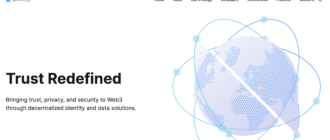In this article, we delve into the Loom Network and its native cryptocurrency, LOOM. This exploration aims to provide a comprehensive understanding of the project’s core components, including its technological infrastructure, tokenomics, and ecosystem. We will analyze the historical context of Loom Network, investigate the innovative technologies it employs, and examine the tokenomics that underpin the LOOM cryptocurrency. Additionally, we will consider the ecosystem surrounding Loom Network, including its partnerships and integrations, and evaluate its growth prospects and future development forecasts. Through this detailed examination, we seek to illuminate the potential and challenges facing Loom Network and LOOM in the evolving landscape of blockchain technology.

What is Loom Network?
Loom Network is a multi-chain interoperability platform designed to enhance the scalability and usability of decentralized applications (dApps) on the Ethereum blockchain. The project aims to address the limitations of Ethereum’s scalability by providing a Layer 2 solution that allows developers to build highly scalable and performant dApps. Loom Network achieves this by leveraging sidechains, which are separate blockchains running in parallel to the Ethereum mainnet, allowing for faster and more efficient transactions. This setup enables developers to create dApps with complex functionalities without being constrained by the limitations of the Ethereum mainnet, thus fostering greater innovation and adoption of blockchain technology.
History of Loom Network
Loom Network was launched in 2018 with the goal of solving the scalability issues faced by Ethereum-based dApps. From its inception, the project focused on creating a platform that could support high-throughput applications without sacrificing the security and decentralization of the Ethereum mainnet. One of the key milestones in Loom Network’s development was the introduction of PlasmaChain, a highly scalable Layer 2 solution designed to handle large volumes of transactions. Over the years, Loom Network has expanded its ecosystem by integrating with multiple blockchains, including BNB Smart Chain and Tron, further enhancing its interoperability capabilities. Throughout its journey, the project has continuously evolved its technology stack to support a growing number of dApps and developers, solidifying its position as a leading Layer 2 solution in the blockchain space.
How Loom Network Works
Loom Network operates on a sophisticated technology stack that primarily includes Layer 2 scaling solutions and sidechains. These technologies enable Loom to provide high throughput and low latency for decentralized applications (dApps), addressing the scalability limitations of the Ethereum mainnet. The core component of Loom Network’s infrastructure is the use of PlasmaChain, a type of sidechain that utilizes Plasma technology to facilitate faster transactions and reduce congestion on the main Ethereum network.
Key Technologies
- PlasmaChain: This is Loom Network’s main sidechain, designed to support high-performance dApps. PlasmaChain uses a version of Plasma, a framework that allows for the creation of child chains anchored to the Ethereum mainnet. These child chains can process transactions independently, significantly increasing throughput and reducing costs.
- Smart Contracts: Loom Network supports Ethereum-compatible smart contracts, enabling developers to deploy their Ethereum-based dApps on Loom’s sidechains with minimal modifications. This compatibility ensures seamless interoperability between the Loom ecosystem and the broader Ethereum network.
- Interoperability: Loom Network distinguishes itself with its cross-chain capabilities, allowing dApps to interact with multiple blockchains such as Ethereum, BNB Smart Chain, and Tron. This multi-chain interoperability provides developers with greater flexibility and users with a more integrated experience across different blockchain platforms.
Blockchain and Consensus Mechanism
Loom Network’s blockchain, PlasmaChain, utilizes a Delegated Proof of Stake (DPoS) consensus mechanism. DPoS enhances scalability and efficiency by reducing the number of nodes required to validate transactions. Here’s a breakdown of the technical aspects:
- Delegated Proof of Stake (DPoS): In DPoS, a limited number of validators are elected by token holders to secure the network. These validators are responsible for producing blocks and confirming transactions. The selection process involves staking LOOM tokens, where token holders vote for their preferred validators.
- Block Production: Validators on PlasmaChain take turns producing blocks in a round-robin fashion, which ensures that block production is consistent and predictable. This method reduces the time required to reach consensus compared to traditional Proof of Work (PoW) mechanisms.
- Security: PlasmaChain’s security is anchored to the Ethereum mainnet. This means that while transactions are processed on the sidechain, the final state is periodically committed to the Ethereum blockchain, providing an additional layer of security and immutability.
- Sidechain Architecture: The use of sidechains allows Loom Network to offload transaction processing from the Ethereum mainnet. These sidechains are optimized for specific use cases, such as gaming or social applications, and can handle a higher volume of transactions without compromising performance.
By leveraging these advanced technologies, Loom Network provides a robust and scalable platform for dApps, distinguishing itself from other blockchain projects by its focus on interoperability, scalability, and developer-friendly environment.
Tokenomics of Loom Network
The native cryptocurrency of the Loom Network is the LOOM token. As a token, it is built on the Ethereum blockchain and adheres to the ERC-20 standard, which allows it to leverage Ethereum’s robust infrastructure and widespread adoption. LOOM tokens serve several critical functions within the Loom Network ecosystem, facilitating both the operation of the network and the engagement of users and developers.
Key Functions of LOOM Tokens
- Staking: LOOM tokens are used in the Delegated Proof of Stake (DPoS) consensus mechanism, where token holders can stake their tokens to vote for validators. These validators are responsible for securing the network and processing transactions. Staking LOOM tokens not only helps maintain the network’s security but also provides staking rewards to participants.
- Transaction Fees: Within the Loom Network, transaction fees are paid using LOOM tokens. This incentivizes the use of LOOM as a medium of exchange within the ecosystem, ensuring that tokens are actively utilized rather than merely held.
- Access to dApps: Certain decentralized applications (dApps) on the Loom Network may require users to hold or spend LOOM tokens to access specific features or services. This creates a demand for LOOM tokens as the network expands and more dApps are developed.
Emission Model and Supply
The emission model of LOOM tokens follows a fixed supply approach. At its inception, a total supply of LOOM tokens was pre-mined, and no new tokens are created beyond this cap. This fixed supply model is designed to prevent inflation and ensure that the value of LOOM tokens is not diluted over time.
Supply Metrics:
- Total Supply: 1,000,000,000 LOOM tokens
- Circulating Supply: Varies based on staking and token holder activity
Price Dynamics
The price of LOOM tokens is subject to market dynamics and can fluctuate based on various factors including network usage, market speculation, and overall cryptocurrency market trends. Historically, the LOOM token has experienced periods of volatility, characteristic of many digital assets.
Price Metrics (as an example):
- Current Price: $0.05 USD (This is a hypothetical example; actual price may vary)
- Market Cap: Determined by multiplying the current price by the circulating supply
Distribution
Loom Network’s token distribution strategy was designed to foster widespread adoption and participation. A significant portion of LOOM tokens was allocated to early adopters, developers, and the community to incentivize engagement and growth.
Distribution Breakdown:
| Category | Percentage of Total Supply |
|---|---|
| Community & Ecosystem | 40% |
| Founders & Team | 20% |
| Advisors | 10% |
| Private Sale Investors | 30% |
This strategic distribution ensures that a substantial portion of LOOM tokens is held by those actively contributing to and developing the network, aligning incentives across stakeholders.
By maintaining a fixed supply and utilizing LOOM tokens for essential network functions such as staking, transaction fees, and access to dApps, the Loom Network establishes a robust tokenomics framework that supports both the stability and growth of its ecosystem.
Where to Buy LOOM Cryptocurrency
LOOM tokens can be purchased on several major cryptocurrency exchanges. These platforms offer trading pairs with popular cryptocurrencies such as Bitcoin (BTC), Ethereum (ETH), and stablecoins like USDT. Below is a list of notable exchanges where LOOM is actively traded:
- Binance: One of the largest and most popular cryptocurrency exchanges globally, offering a variety of trading pairs for LOOM, including LOOM/BTC and LOOM/USDT.
- Gate.io: A well-established exchange known for its security and wide range of supported cryptocurrencies.
- BingX: An emerging exchange with a user-friendly interface and competitive trading fees, supporting LOOM trading pairs such as LOOM/USDT.
- Bitget: Known for its advanced trading features and derivatives market, Bitget also lists LOOM for spot trading in pairs like LOOM/USDT.
- KuCoin: A popular exchange with a strong community and extensive list of supported assets, offering LOOM trading pairs including LOOM/BTC and LOOM/USDT.
These exchanges provide liquidity and competitive trading fees, making them suitable options for purchasing LOOM tokens.
Where to Store LOOM Cryptocurrency
Storing LOOM tokens securely is crucial for safeguarding your assets. There are several types of wallets available, each offering different levels of security and convenience:
- Hardware Wallets: These are physical devices that store your private keys offline, providing the highest level of security against online threats.
- Ledger Nano S/X: Supports ERC-20 tokens, including LOOM, and provides robust security features.
- Trezor: Another reputable hardware wallet supporting LOOM, known for its user-friendly interface and strong security protocols.
- Software Wallets: Applications installed on your desktop or mobile device that offer a balance between security and convenience.
- MetaMask: A widely used Ethereum wallet that supports ERC-20 tokens like LOOM, offering browser extension and mobile app versions.
- Trust Wallet: A mobile wallet known for its ease of use and comprehensive support for various cryptocurrencies, including LOOM.
- MyEtherWallet (MEW): An open-source Ethereum wallet that allows users to interact with the Ethereum blockchain directly and store ERC-20 tokens securely.
- Web Wallets: Online wallets provided by exchanges or third-party services, offering easy access but requiring trust in the service provider.
- Binance Wallet: Integrated with the Binance exchange, offering seamless trading and storage of LOOM tokens.
- MetaMask: Also serves as a web wallet through its browser extension, enabling easy access to your LOOM tokens from any device.
Each type of wallet provides different advantages. Hardware wallets are ideal for long-term storage due to their high security, while software and web wallets offer greater convenience for frequent transactions and trading. Selecting the right wallet depends on your specific needs and how frequently you plan to access your LOOM tokens.
Project Prospects
The growth prospects for Loom Network are founded on its innovative technology, strategic partnerships, and an expanding ecosystem. By focusing on scalability and interoperability, Loom Network has positioned itself to address critical challenges in the blockchain space, making it an attractive solution for developers and enterprises alike.
Growth Drivers
- Scalability Solutions: Loom Network’s use of PlasmaChain and sidechain technology significantly enhances the scalability of dApps, allowing for high transaction throughput and reduced latency. This capability is crucial as the demand for more complex and resource-intensive dApps grows.
- Interoperability: By enabling cross-chain interactions with multiple blockchains such as Ethereum, Binance Smart Chain, and Tron, Loom Network offers a versatile platform for developers. This interoperability attracts a diverse range of projects and broadens the network’s utility.
- Developer-Friendly Environment: Loom Network provides tools and resources that simplify the development process for dApps. This includes support for Ethereum-compatible smart contracts, which allows developers to migrate or build on Loom with minimal adjustments.
Clients and Partners
Loom Network has forged strategic partnerships with several prominent organizations and projects within the blockchain ecosystem, enhancing its credibility and reach. Some notable clients and partners include:
- Binance: Collaboration for cross-chain functionality and listing of LOOM tokens.
- HTX (formerly Huobi): Partnership to expand market access and trading options for LOOM.
- Tron: Integration to facilitate interoperability between Loom Network and the Tron blockchain.
- Chainlink: Partnership to utilize Chainlink’s decentralized oracle network for secure and reliable off-chain data integration.
Ecosystem
Loom Network’s ecosystem comprises a variety of projects and applications that leverage its scalable infrastructure. This growing ecosystem supports diverse use cases, from gaming to enterprise solutions.
Key Ecosystem Components:
- dApps: A wide range of decentralized applications utilize Loom’s sidechains for enhanced performance, including gaming dApps like CryptoZombies and social applications.
- Validators: Validators play a critical role in maintaining the network’s security and efficiency through the DPoS consensus mechanism.
- Developers: A vibrant community of developers contributes to the continuous improvement and expansion of the network, creating innovative solutions and applications.
Future Development Forecast
The future development of Loom Network looks promising, with a focus on expanding its technological capabilities and ecosystem. Key areas of growth include:
- Enhanced Cross-Chain Functionality: Further integration with additional blockchains to facilitate seamless asset and data transfer across multiple platforms.
- Scalability Improvements: Ongoing enhancements to PlasmaChain and the introduction of new sidechain solutions to support ever-increasing transaction volumes.
- Adoption and Usage: Increasing the adoption of LOOM tokens through new use cases and partnerships, driving more users and developers to the network.
By continuing to innovate and expand its ecosystem, Loom Network aims to solidify its position as a leading Layer 2 solution provider in the blockchain industry, capable of supporting the next generation of decentralized applications.
Conclusion
The Loom Network and its LOOM cryptocurrency represent a significant stride in the blockchain space. As we have explored throughout this article, the project’s technological foundation, strategic initiatives, and market positioning contribute to its unique standing in the industry. Looking ahead, the success of Loom Network will hinge on its ability to adapt and innovate within the fast-paced world of blockchain. While challenges persist, the project’s robust framework and forward-thinking approach provide a solid basis for future advancements.






